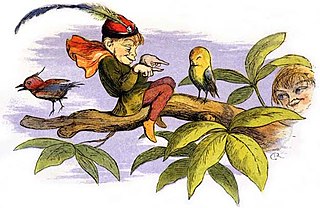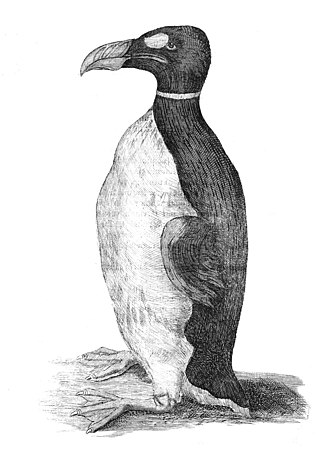Related Research Articles
A boggart is a creature in English folklore, either a household spirit or a malevolent genius loci inhabiting fields, marshes, or other topographical features. Other names of this group include bug, bugbear, bugaboo or bug-a-boo, bogey, bogun, bogeyman, bogle, etc., presumably all derived from Old English pūcel, and related to the Irish púca and the pwca or bwga of Welsh mythology.

The River Ancholme is a river in Lincolnshire, England, and a tributary of the Humber. It rises at Ancholme Head, a spring just north of the village of Ingham and immediately west of the Roman Road, Ermine Street. It flows east and then north to Bishopbridge west of Market Rasen, where it is joined by the Rase. North of there it flows through the market town of Brigg before draining into the Humber at South Ferriby. It drains a large part of northern Lincolnshire between the Trent and the North Sea.

Spalding is a market town on the River Welland in the South Holland district of Lincolnshire, England. The town had a population of 31,588 at the 2011 census. The town is the administrative centre of the South Holland District. The town is located between the cities of Peterborough and Lincoln, as well as the towns of Bourne, March, Boston, Wisbech, Holbeach and Sleaford.

English folklore consists of the myths and legends of England, including the English region's mythical creatures, traditional recipes, urban legends, proverbs, superstitions, and folktales. Its cultural history is rooted in Celtic, Christian, and Germanic folklore.

The boobrie is a mythological shapeshifting entity inhabiting the lochs of the west coast of Scotland. It commonly adopts the appearance of a gigantic water bird resembling a cormorant or great northern diver, but it can also materialise in the form of various other mythological creatures such as a water bull.

Spilsby is a market town, civil parish and electoral ward in the East Lindsey district of Lincolnshire, England. The town is adjacent to the main A16, 33 miles (53 km) east of the county town of Lincoln, 17 miles (27 km) north-east of Boston and 13 miles (21 km) north-west of Skegness. It lies at the southern edge of the Lincolnshire Wolds and north of the Fenlands, and is surrounded by scenic walking, nature reserves and other places to visit.

Saint Guthlac of Crowland was a Christian hermit and saint from Lincolnshire in England. He is particularly venerated in the Fens of eastern England.
Yallery Brown is a mischievous fairy-like nature spirit in an old Lincolnshire folk tale from England, which itself is usually named after the creature.
The Folklore Society (FLS) is a national association in the United Kingdom for the study of folklore.
William Crooke was a British orientalist and a key figure in the study and documentation of Anglo-Indian folklore. He was born in County Cork, Ireland, and was educated at Erasmus Smith's Tipperary Grammar School and Trinity College, Dublin.

Fulstow is a marsh village and civil parish in the East Lindsey district of Lincolnshire, England. It is situated 6 miles (10 km) north of Louth and 8 miles (13 km) south of Grimsby.
Mary MacLeod Banks was a folklorist, born Mary MacLeod McConnel in Scotland. She was president of the Folklore Society from 1937 to 1939.
This list of the works of William Crooke (1848–1923) represents much of his literary output in pursuit of his interests in ethnology and folklore, for which he was far many years considered to be a leading authority.

Toynton All Saints is a village and civil parish in the East Lindsey district of Lincolnshire, England, about 1.5 miles (2.4 km) south of the town of Spilsby.

John Gregorson Campbell was a Scottish folklorist and Free Church minister at the Tiree and Coll parishes in Argyll, Scotland. An avid collector of traditional stories, he became Secretary to the Ossianic Society of Glasgow University in the mid-1850s. Ill health had prevented him taking up employment as a Minister when he was initially approved to preach by the Presbytery of Glasgow in 1858 and later after he was appointed to Tiree by the Duke of Argyll in 1861, parishioners objected to his manner of preaching.

The stoor worm, or Mester Stoor Worm, was a gigantic evil sea serpent of Orcadian folklore, capable of contaminating plants and destroying animals and humans with its putrid breath. It is probably an Orkney variant of the Norse Jörmungandr, also known as the Midgard Serpent, or world serpent, and has been described as a sea dragon.

The countless stones is a motif that appears in English and Welsh folklore. It is associated with various megalithic monuments, including chambered long barrows from the Early Neolithic and the stones circles of the Late Neolithic and Early Bronze Age. The motif holds that an individual attempting to count the number of stones in the monument will be unable to do so.
Maurice Willmore Barley M.A., F.S.A., F.R.Hist.S., was an English historian and archaeologist, specialising in medieval settlements and historic buildings.

Ethel Rudkin was an English writer, historian, archaeologist and folklorist from Lincolnshire. She pioneered the collection of folk material, particularly from Lincolnshire, and her collections are now part of several public institutions, including the North Lincolnshire Museum.
Thomas Fairman Ordish (1855-1924), sometimes also referred to as T. Fairman Ordish was a British folklorist, noted for his interest in traditional drama and folk play, early theatre and the history of London. He is credited as having undertaken "the first major investigation of British traditional drama".
References
- ↑ "Tidy Mun". Tales of Britain. Retrieved 19 May 2022.
- ↑ Peacock, E (1889) A Glossary of Words used in the Wapentakes of Manley and Corringham, Lincolnshire. English Dialect Society: Trubner page 562
- 1 2 Balfour, M. C. (June 1891). "Legends Of The Cars". Folk-Lore. Folklore Enterprises, Ltd. 2 (2): 145–170. doi: 10.1080/0015587x.1891.9720054 . JSTOR 1253522.
- ↑ Horn, Darwin (1987). "Tiddy Mun's Curse and the Ecological Consequences of Land Reclamation". Folklore. 98 (1): 11–15. doi:10.1080/0015587x.1987.9716391. JSTOR 1259396.
- 1 2 3 Rudkin, E.H. (1955). "Folklore of Lincolnshire: Especially the Low-Lying Areas of Lindsey". Folklore. 66 (4): 393–395. doi:10.1080/0015587X.1955.9717498. JSTOR 1258804.
- ↑ "Name is from Bog sprite". Fenland Citizen. p. 14.
- ↑ Borlik, Todd (2013). "Caliban and the Fen Demons of Lincolnshire: The Englishness of Shakespeare's Tempest". Shakespeare: Journal of the British Shakespeare Association. 9 (1): 21–51. doi:10.1080/17450918.2012.705882. S2CID 162224375 . Retrieved 14 December 2014.